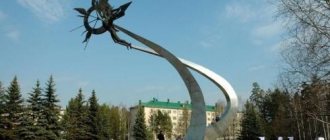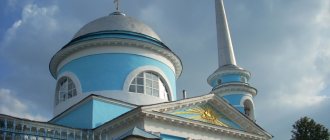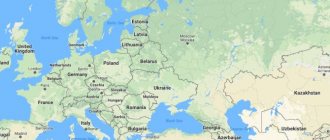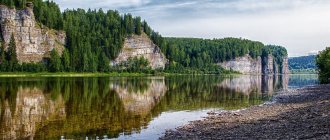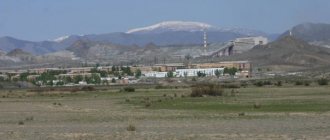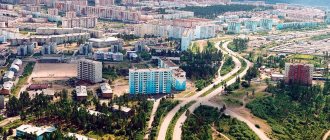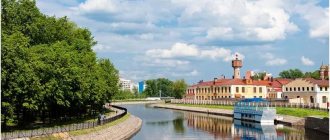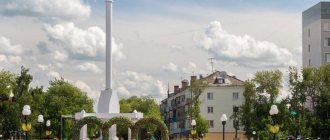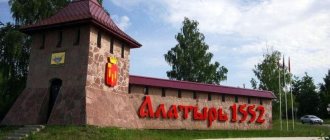A new microdistrict is being actively built, kindergartens are being built and renovated, the sphere of private kindergartens and development centers is developing, and private medicine is operating. Shopping centers and specialty stores, good transport links, consumer services.
But the economic situation leaves much to be desired, so by Order of the Government of the Russian Federation dated July 29, 2014 N 1398-r (as amended on May 13, 2016) “On approval of the list of single-industry towns”, it is included in the list of single-industry towns of the Russian Federation with the risk of worsening the socio-economic situation.
1.2. Route Novoaltaysk-Barnaul
The distance from Novoaltaisk to Barnaul in a straight line is about 12 kilometers, along the road a little further. So, it’s not unreasonable for the residents of Altaika to believe that they live practically in Barnaul, because getting to it is very convenient: there are many minibuses. Moreover, they go very often. Sometimes, getting from Novoaltaysk to Barnaul and from Barnaul to Novoaltaysk is faster than getting from one district of Barnaul to another during rush hour.
The road from Novoaltaisk to Barnaul passes next to the railway tracks, then you need to cross the Ob River along the “Old Bridge”. There are practically no traffic jams before the bridge. But during the trip you can admire the landscape outside the window.
And when you cross the Ob, you can’t help but be impressed by its power and grandeur, from the height of the bridge - it’s very beautiful!
There is a railway bridge parallel to the road bridge. Travel time by minibus from the center of Novoaltaisk to October Square in Barnaul is about 30 minutes.
Geography[ | ]
Located on the right bank of the Ob River, in the lower reaches of its right tributary of the Chesnokovka River, about 12 km from the center of Barnaul (opposite it across the Ob River). The urban district of Novoaltaisk borders in the southwest with the urban district of the city of Barnaul, in the east, north, south and northwest - with the Pervomaisky district of the Altai Territory.
A large transport hub, Altayskaya station is one of the ten largest railway junctions in the Russian Federation.
The area of the city is 72.2 km², the urban district is 74.94 km²[3].
The main industrial and municipal warehouse enterprises are concentrated within the boundaries of the Southern Industrial Hub and in the northwestern part of the city, along the railroad right of way. The territory of the northern and partly southwestern part of the Southern residential area is built up with one-story individual residential buildings. The southern and northern parts of the Central Residential District form business and administrative centers, around which compact residential neighborhoods are concentrated, having a clear planning structure with building heights from 4 to 16 floors.
The city is located in the forest-steppe zone of the West Siberian Lowland with a sharply continental climate, in a zone of risky agriculture.
Average annual air temperature: 2 °C. The absolute minimum temperature in January: −52 °C. The absolute maximum temperature in July: +38 °C. 437 mm of precipitation falls per year, 65% of which falls during the warm period. Snow cover lies on average from early October to late March, reaching an average height of 1200 mm in winter. Climate of Novoaltaysk
| Index | Jan. | Feb. | March | Apr. | May | June | July | Aug. | Sep. | Oct. | Nov. | Dec. | Year |
| Average maximum, °C | −10 | −8,9 | −1,4 | 9,0 | 19,0 | 24,7 | 26,5 | 23,3 | 17,6 | 7,5 | −2,6 | −9,1 | 8,2 |
| Average temperature, °C | −15,1 | −14,8 | −7,3 | 3,2 | 12,1 | 18,0 | 20,1 | 17,0 | 11,3 | 2,8 | −6,9 | −13,8 | 2,2 |
| Average minimum, °C | −20,1 | −20,7 | −13,2 | −2,5 | 5,2 | 11,4 | 13,7 | 10,7 | 5,1 | −1,9 | −11,1 | −18,5 | −2,7 |
| Precipitation rate | 26 | 24 | 20 | 27 | 40 | 45 | 59 | 49 | 31 | 51 | 36 | 29 | 437 |
| Source: Climate of Novoaltaisk (unspecified) . ru.climate-data.org . Access date: April 22, 2022. | |||||||||||||
1.4. Life in Novoaltaysk
Living in the city is quite comfortable for those who are not interested in noisy, busy city life. When you find yourself here, you notice that the rhythm of life is slower and calmer. There is not a lot of traffic, as on the central roads of Barnaul, so traffic is easier here.
There is everything for a comfortable stay with children: schools, kindergartens, children's clinics, playrooms, clubs and sections.
True, the improvement is more noticeable in the new part of the city; the old part is more reminiscent of an urban-type settlement with old-built houses.
It is very comfortable to live in the area of the Labor Palace of Culture: a spacious landscaped square where city events and fairs are held; here this place is very popular with mothers and children. Nearby is a recreation park with a mini-zoo. Nearby there are two large shopping malls and a “Park”, a collection of various specialized stores. A little further away is the Asia shopping center - the residential area next to it is also quite cozy and well-maintained. If we drive even further, we find ourselves in a new microdistrict under construction.
Within the boundaries of Novoalaisk there are several gardening areas, which are conveniently accessible both by your own car and by public transport.
There is a swimming pool and a large sports complex Ob. The Palace of Culture creates a platform for versatile additional education of children and holds significant events; the Cosmos cinema performs the same functions.
The taxi service is well developed; both local and Barnaul companies operate.
Population[ | ]
Data from 1996 are presented in the new boundaries of the city in 2004 after 2 urban settlements and 1 rural village entered the city limits.
| Population | ||||||||||
| 1939[9] | 1959[10] | 1967[9] | 1970[11] | 1973[9] | 1976[9] | 1979[12] | 1982[13] | 1986[9] | 1987[14] | 1989[15] |
| 9000 | ↗33 953 | ↗46 000 | ↗49 498 | ↗51 000 | ↗52 000 | ↘50 034 | ↗51 000 | ↘50 000 | ↗51 000 | ↗53 642 |
| 1992[9] | 1996[16] | 1997[16] | 1998[16] | 1999[16] | 2000[16] | 2001[16] | 2002[16] | 2003[16] | 2004[16] | 2005[16] |
| ↗55 200 | ↗70 458 | ↗71 642 | ↗73 500 | ↘73 400 | ↗73 600 | ↗73 700 | ↘73 500 | ↗73 554 | ↗73 889 | ↗73 986 |
| 2006[16] | 2007[16] | 2008[16] | 2009[16] | 2010[17] | 2011[18] | 2012[18] | 2013[19] | 2014[20] | 2015[21] | 2016[22] |
| ↘73 889 | ↘73 648 | ↘73 182 | ↘73 068 | ↘70 437 | ↗70 473 | ↘70 317 | ↗70 357 | ↗70 988 | ↗72 308 | ↗73 134 |
| 2017[23] | 2018[24] | 2019[25] | 2020[26] | 2021[1] | ||||||
| ↗73 712 | ↘73 439 | ↗73 769 | ↗74 556 | ↗74 586 | ||||||
As of January 1, 2022, in terms of population, the city was in 221st place out of 1,116[27]cities of the Russian Federation[28].
National composition[29][ | ]
| nationality | men | women | Total | % | |
| Russians | 33 423 | 36 072 | 69 495 | 94,5 | |
| Germans | 507 | 545 | 1 052 | 1,43 | |
| Ukrainians | 458 | 522 | 980 | 1,33 | |
| Tatars | 153 | 133 | 286 | 0,39 | |
| Belarusians | 128 | 112 | 240 | 0,32 | |
| Armenians | 130 | 65 | 195 | 0,26 | |
| Mordovians | 76 | 81 | 157 | 0,21 | |
| gypsies | 91 | 61 | 152 | 0,2 | |
| total: | 35 630 | 37 914 | 73 544 | 100 | |
1.5. Where to get a job in Novoaltaysk
But working here is quite difficult. There are not many key employers in Novoaltaysk, therefore, a significant part of the city's residents work in Barnaul. Although, it’s worth rephrasing - there are employers, but in the period of modern economic realities, it is very difficult to get a job at large industrial enterprises, and the level of wages leaves much to be desired.
Major employers in Novoaltaysk include:
- Maria-Ra trading networks, a large logistics center (warehouse) Maria-Ra is located here;
- chains Anix, Holiday, the Magnit hypermarket has recently opened;
- Euroset, Megafon, MTS;
- networks of microfinance organizations are thriving, and there are branches of several banks;
- Specialists in the field can get a job in the police department, medical institutions, they are always waiting for new employees in the educational sector - kindergartens, schools;
- the large Altaiskaya railway station and other divisions of Russian Railways provide jobs for many residents of Novoaltaisk, although it is now very difficult to get a job there, especially without a specialized education;
- Of the manufacturing enterprises, it is worth noting Altaykhleb (production of bakery products), Svit (sewing enterprise)
- in industry, we can note OJSC Altaivagon, NZZhBI (Novoaltaisky Plant of Reinforced Concrete Products named after G.S. Ivanov), CJSC Altaikrovlya, OJSC Beloyarsk Mast Impregnation Plant. True, lately we have hardly heard any positive reviews about working there. Look for details yourself.
- Also worth noting is the large enterprise Alterra, the Solnechny Park Hotel, and several large shopping and entertainment centers.
- Russian Post and Sibirtelecom can also be considered potential employers.
History[ | ]
- The history of the city as a settlement begins in X\/||| (18) century with the penetration of the Russian population from the European part of Russia into Siberia, with the founding of the Beloyarsk fortress in 1717, and then the villages of Chesnokovka (1736) and Bazhovo (1737).[4]
- In 1915, the Altai Railway passed through it, and a station village appeared.
- In 1934, a woodworking plant was built, and in 1941, the carriage building plant was evacuated from Dneprodzerzhinsk.
- The status of a workers' settlement near Chesnokovka has been since 1936.
- From January 27, 1939, it was the center of the Barnaul district (renamed Chesnokovsky on May 19, 1955, disbanded on November 26, 1957).
- On May 8, 1942, the workers' settlement was given the status of a city.
- On April 18, 1962, the city of Chesnokovka was renamed Novoaltaisk.
In December 2003, 3 settlements were included within the city limits of Novoaltaisk (60,015 inhabitants according to the 2002 census): 2 urban-type settlements - Novogorsky (2,273 inhabitants, 2002) and Beloyarsk (10,818 inhabitants, 2002), as well as the subordinate the latter has 1 rural settlement - the village of Tokarevo (438 inhabitants, 2002)[6][7].
By Order of the Government of the Russian Federation dated July 29, 2014 No. 1398-r “On approval of the list of single-industry towns,” the urban district of Novoaltaisk is included in the category “Single-industry municipalities of the Russian Federation (single-industry towns), in which there are risks of deterioration of the socio-economic situation” [8].
1.8. Population of Novoaltaisk
According to statistics, the population of Novoaltaisk has been increasing since 2013. So, in 2013, 70,357 people lived here, and according to 2016 data, 73,134 people live in Novoaltaysk. Perhaps this can be associated with the construction of new buildings, the cost of housing in which is an order of magnitude lower than in Barnaul, and with an increase in the birth rate.
In preparing the material, information from the website ru.wikipedia.org and information provided by interviewed city residents was used. © ecoaltai.rf
If you have something to say about Novoaltaisk, please mark it in the comments, you will be grateful to hundreds of users who are looking for reviews about Novoaltaisk and reviews about life in Novoaltaisk.
Etymology[ | ]
Originated in the mid-18th century as the village of Chesnokovka
.
The name comes from the fact that metallurgy and forging were previously developed here and comes from the words “honest forging” since Altai people do not lie or deceive - honest ones have been recorded in sources since the 16th century. Since 1942 - a city with the same name, in 1962 it was renamed Novoaltaisk
[2].
According to other sources, the name Chesnokovka takes its name from the name of the river of the same name, in the floodplain of which wild garlic grew.
Territorial division[ | ]
Districts of Novoaltaysk: Central Beloyarsky Novogorsky
City Novoaltaysk is administratively and historically divided into 3 districts within the framework of residential development planning, the boundaries of which are the railroad right of way, the M-52 “Chuysky Tract” highway and the Chesnokovka River[30][31]:
- Central region - 60 thousand people. (2007),
- Beloyarsky district - 11 thousand people. (2007),
- Novogorsky district - 3 thousand people. (2007)[32].
The administrations of the Beloyarsky and Novogorsky districts also function within the city administration[33][34].
In 2004, the Beloyarsky district included the territories of two settlements abolished in 2003 (the urban-type settlement of Beloyarsk and the village of Tokarevo), and the Novogorsky district was formed on the basis of the former (until 2003) urban-type settlement of Novogorsky.
Notes[ | ]
- ↑ 12
The permanent population of the Russian Federation by municipalities as of January 1, 2022 (Russian). Retrieved April 27, 2022. Archived May 2, 2022. - Pospelov, 2008, p. 316.
- Database of indicators of municipalities (Altai Territory) (Russian). www.gks.ru.
_ Access date: April 22, 2022. - Historical information (unspecified)
. www.novoaltaysk.ru. Access date: January 20, 2022. - “Closer to each other” - an article in the weekly magazine “Continent of Siberia” inaccessible
link -
history
). - All-Russian population census 2002. Volume. 1, table 4. Population of Russia, federal districts, constituent entities of the Russian Federation, districts, urban settlements, rural settlements - regional centers and rural settlements with a population of 3 thousand or more (unspecified)
. Archived from the original on February 3, 2012. - Resolution of the Altai Regional Council of People's Deputies of December 2, 2003 N 416 “On some changes in the administrative-territorial structure of the Altai Territory” (Russian). docs.cntd.ru.
_ Access date: April 22, 2022. - Order of the Government of the Russian Federation of July 29, 2014 No. 1398-r “On approval of the list of single-industry towns”
- ↑ 123456
People's encyclopedia "My City". Novoaltaysk - All-Union Population Census of 1959. The size of the urban population of the RSFSR, its territorial units, urban settlements and urban areas by gender (Russian). Demoscope Weekly. Access date: September 25, 2013. Archived April 28, 2013.
- All-Union Population Census of 1970 The size of the urban population of the RSFSR, its territorial units, urban settlements and urban areas by gender. (Russian). Demoscope Weekly. Access date: September 25, 2013. Archived April 28, 2013.
- All-Union Population Census of 1979 The size of the urban population of the RSFSR, its territorial units, urban settlements and urban areas by gender. (Russian). Demoscope Weekly. Access date: September 25, 2013. Archived April 28, 2013.
- National economy of the USSR. 1922-1982: anniversary statistical yearbook: [arch. February 16, 2018] / Central Statistical Office of the USSR. - Moscow: Finance and Statistics, 1982. - 624 p.
- National economy of the USSR for 70 years: anniversary statistical yearbook: [arch. June 28, 2016] / USSR State Committee on Statistics. - Moscow: Finance and Statistics, 1987. - 766 p.
- All-Union population census of 1989. Urban population (undefined)
. Archived from the original on August 22, 2011. - ↑ 1234567891011121314
Resident population as of January 1 - Results of the 2010 All-Russian Population Census for the Altai Territory. Volume 1. Number and distribution of population (undefined)
. Retrieved March 6, 2015. Archived March 6, 2015. - ↑ 12
Population by municipalities as of January 1, 2011, 2012, 2013 (including by settlements) according to current accounting data - Population of the Russian Federation by municipalities as of January 1, 2013. - M.: Federal State Statistics Service Rosstat, 2013. - 528 p. (Table 33. Population of urban districts, municipal districts, urban and rural settlements, urban settlements, rural settlements) (undefined)
. Retrieved November 16, 2013. Archived November 16, 2013. - Altai region. Population estimates as of January 1, 2014 and average for 2013 (unspecified)
. Retrieved July 3, 2022. Archived July 3, 2017. - Population of the Russian Federation by municipalities as of January 1, 2015 (unspecified)
. Access date: August 6, 2015. Archived August 6, 2015. - Population of the Russian Federation by municipalities as of January 1, 2016 (Russian) (October 5, 2018). Retrieved May 15, 2022. Archived May 8, 2022.
- Population of the Russian Federation by municipalities as of January 1, 2022 (Russian) (July 31, 2017). Retrieved July 31, 2022. Archived July 31, 2022.
- Population of the Russian Federation by municipalities as of January 1, 2022 (Russian). Retrieved July 25, 2018. Archived July 26, 2022.
- Population of the Russian Federation by municipalities as of January 1, 2022 (Russian). Retrieved July 31, 2019. Archived May 2, 2022.
- Population of the Russian Federation by municipalities as of January 1, 2022 (Russian). Date accessed: October 17, 2022. Archived October 17, 2022.
- taking into account the cities of Crimea
- https://rosstat.gov.ru/storage/mediabank/bul_Chislen_nasel_MO-01-01-2021.rar Population of the Russian Federation by municipalities as of January 1, 2022 (1.85 Mb, 07/30/2021)
- Wayback Machine (unspecified)
(unavailable link) (October 25, 2018). Date accessed: January 3, 2021. Archived October 25, 2022. - Explanatory note Part 2. Regulations on territorial planning (Russian). www.novoaltaysk.ru
.
Date of access: April 22, 2022. General plan of Novoaltaisk (Russian). www.novoaltaysk.ru
. Date of access: April 22, 2022. - Barnaul, 2009
(Russian). www.novoaltaysk.ru
.
Date of access: April 22, 2022. General plan of Novoaltaisk (Russian). www.novoaltaysk.ru
. Date of access: April 22, 2022. - Barnaul, 2009- Explanatory note Part 1. Justification materials (Russian). www.novoaltaysk.ru
.
Date of access: April 22, 2022. General plan of Novoaltaisk (Russian). www.novoaltaysk.ru
. Date of access: April 22, 2022. - Barnaul, 2009 - Administrations of Beloyarsky and Novogorsky districts (Russian). www.novoaltaysk.ru
. Access date: April 22, 2022. - Resolutions / orders of the City Administration (Russian). www.novoaltaysk.ru
. Access date: April 22, 2022. - Trolleybus (undefined)
.
asfera.info
.
Date of access: April 22, 2022. The route “Barnaul-Novoaltaysk” will appear in the region (unspecified)
.
asfera.info
. Access date: April 22, 2022. - Information from the Unified State Register of Cultural Heritage Objects (historical and cultural monuments) of the peoples of the Russian Federation
